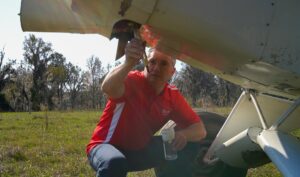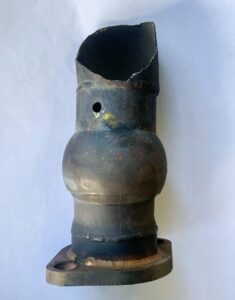
Why is preflighting an aircraft crucial?
Preflighting ensures the safety and airworthiness of the aircraft before taking off. By conducting a comprehensive preflight, potential issues can be identified and addressed on the ground before they turn serious in the air.
During a preflight, the pilot inspects the aircraft thoroughly, checking for any issues or abnormalities such as loose or worn-out parts, leaks, or damage. They also inspect the fuel and oil levels, engines, and control surfaces as well as verify that all required documents and safety equipment are on board.
How can you preflight inspect the engine?
One preflight inspection item often hastily inspected is the engine. But the engine is the “heart” of the aircraft and ensuring its proper functioning is crucial for safe flight! You must assess the engine’s overall condition, including oil levels and fuel lines. You may also inspect the propeller to ensure it is securely attached, has no nicks or cracks, and is in good shape.
When you check the engine, you can detect signs, such as leaks or cracks, that show themselves before trouble rears its ugly head as a serious malfunction. All areas under the cowling should not be hastily glanced at but instead carefully inspected so you can ascertain what your eyes are seeing. The image below is an example of a broken exhaust found by a student pilot during a preflight inspection. This student was diligent and methodical in following their CFI’s training and preflight checklist.

What’s the big deal about checking the exhaust system?
The exhaust system plays a crucial role in safely expelling engine exhaust gases. Any exhaust system issues could affect the engine’s performance or compromise the aircraft’s airworthiness. By inspecting the exhaust system regularly, you can catch any problems early on, like cracks, leaks, or blockages, which may lead to engine inefficiencies or even carbon monoxide leaks into the cabin.
Additionally, aircraft engines generate significant heat, and the exhaust system is designed to withstand these elevated temperatures. Regular inspection helps identify any signs of heat-related damage, such as corrosion or distortion, which can compromise the system’s structural integrity.
Remember, maintaining a healthy exhaust system contributes to the overall safety, performance, and efficiency of the aircraft.
How to inspect the exhaust system
When it comes to examining the exhaust system, there are a few things you can do to ensure everything is in tip-top shape.
- Visually inspect the exhaust pipes, looking for any signs of damage, cracks, or corrosion. Make sure they are securely attached without any loose connections. Check for any abnormal discoloration, such as blue or white stains, which could indicate engine issues or exhaust blow-by.
- If the aircraft has been flown recently, exercise extreme caution when inspecting a hot exhaust system. Those pipes can reach scorching temperatures! Always follow proper safety procedures and use protective gloves to avoid burns.
- If you notice anything out of the ordinary or suspicious during the inspection, it’s best to consult with a qualified aircraft mechanic (A&P or IA) for a more thorough assessment.
- As a final defense measure, you should have a CO (carbon monoxide) detector in the cabin. They are inexpensive and turn black when exposed to CO. Many glass panels and engine analyzers have optional CO detectors. It is worth the few extra dollars to keep you and your passengers safe.
- If you ever get a CO detector alarm, open any exterior vents to increase fresh air, land as soon as possible, and get the exhaust checked out.
What should you have learned?
Before a plane takes off, preflighting is a crucial step. Think of it as a health check-up for the aircraft to ensure it’s safe and ready to fly. By conducting a detailed preflight, we can spot and fix any issues while the plane is still on the ground. Preflighting involves examining various parts of the aircraft. This includes the engines, the components that control the plane’s direction, and the levels of fuel and oil. It also ensures that all necessary documents and safety equipment are available on board. One part of the preflight that requires careful attention is the engine. It is essential to take your time with this part. Inspecting the engine and the exhaust system is vital to ensuring the plane will fly safely, perform optimally, and use fuel efficiently.

